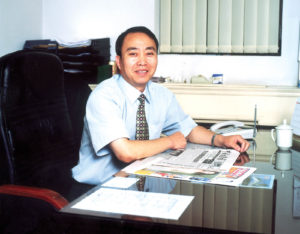Li Ying Lu: The China Textile News (CTN) is the only authorized national newspaper on the textile industry in China. Would you please give us some background on your newspaper?
 Mr. Chi: CTN started in 1986, and is 22 years old this year. The fundamental mission of this newspaper is to offer comprehensive information services to the whole textile industry. We cover the spectrum of the entire industry chain, from raw materials like cotton, hemp, wool, silk and chemical fibers to finished products like garments, home textiles, and other related products and services like textile machinery, education, popular colors, and more.
Mr. Chi: CTN started in 1986, and is 22 years old this year. The fundamental mission of this newspaper is to offer comprehensive information services to the whole textile industry. We cover the spectrum of the entire industry chain, from raw materials like cotton, hemp, wool, silk and chemical fibers to finished products like garments, home textiles, and other related products and services like textile machinery, education, popular colors, and more.
CTN generally reflects the textile industry’s status quo and development trends. It reports the latest regulations on the industry by the central government, and covers the latest market information of both the domestic and international markets. In the past 22 years, with its specialized complete coverage of all textile news, CTN has gradually grown into a very important center of authority in textile news reporting in China.
In August 2006, it was named one of the five most influential national industry newspapers (among 45) by the China National Publishing Agency. CTN circulates internationally and has the largest circulation of any newspaper in China’s textile industry. Companies can subscribe from anywhere in the world.
Do you have an English version of your newspaper?
So far, we don’t have a regular English version. However, we do have English versions of some important industry events, such as particular international trade shows held in China. In 2007, we set up an international trade editing department, responsible for our cooperation with international organizations, foreign embassies in China and foreign invested companies in China.
From your standpoint, what’s the current state of China’s textile industry?
Up to now, our textile industry has acquired fairly advanced equipment, and its processing capacity is one of the best in the world. However, the textile industry in China needs to move up in the international industry value chain.
This can be achieved in two ways: One is to improve its technical renovation, and another is to create its own brands and publicize them.
With regard to technical renovation, the whole industry needs to increase the contribution of technology to value. We have seen many recent trials and improvements. Many companies have started to invest more in technological development, and this is a healthy beginning.
As for the creation and development of brand names, the Chinese textile industry needs to do a lot of work. Although we have seen many brands show up in the market, they are mostly weak and have not established much recognition. Accordingly, most textile products are still at the low end of the global textile industry value chain.
Industrial textiles in China are seeing a steady increase in development. Would you tell us about that?
In 2007, we have seen very fast development in nonwoven and industrial textiles in China. Domestic need for such products is very strong, and has increased steadily over the past few years.
The annual output for all nonwoven products for 2007 was 1.65 million tons, an increase of 18.7 percent increase over the previous year.
Industrial textiles in China accounted for only 8.2 percent of the entire textile industry in the 1980s. In 2006, that percentage grew to 14 percent, and in 2007 it reached 15 percent. It is expected that by 2010, the industrial textiles output will reach 6.12 million tons, accounting for 17 percent of the industry.
The fastest market growth demands are in filtration, geosynthetics, sign fabrics, coated tarpaulins and automotive textiles.
For example, with stricter environmental protection laws coming into force, there is a surging demand for filtration bags in the steel, chemical, cement, and coal industries, and the requirements and standards for those filtration bags have all increased greatly. That gives a lot of room for development for many filtration companies.
With the “go west” development policies now being executed, more and more geosynthetic materials are needed to build trash and wastewater projects to protect the environment in the western part of China. The eastern part of China was developed earlier, and we learned great lessons about environment protection. In this “go west” economic development, there are strict environmental protection laws, and geosynthetic materials are needed more and more in western China, as well as in the eastern part of the country.
Currently, the domestic market demand for automotive textiles is about 200,000 tons per year. More families are buying and have plans to buy private cars in the near future. By 2010, the market demand for automotive textiles will reach 256,000 tons. Most of them are being imported from abroad right now.
In a word, with continuing fast economic development, industrial fabrics are being used in more and more areas like safety and protective applications, construction, and sports facilities. The potential for such structures is enormous. Take the Olympics facilities for example; the swimming pool is the biggest membrane structure in the world.
 TEXTILES.ORG
TEXTILES.ORG


